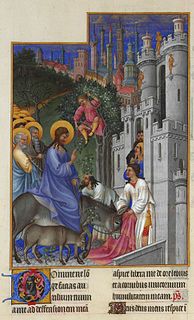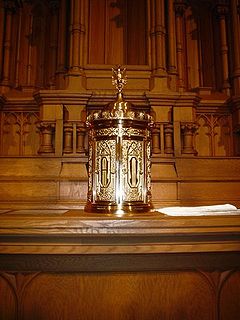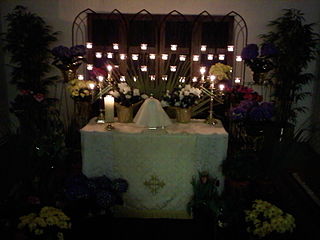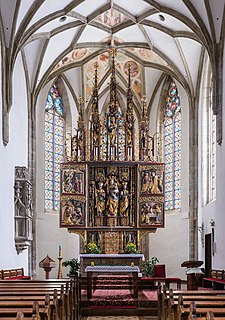
An Easter Sepulchre is a feature of British church interior architecture.

An Easter Sepulchre is a feature of British church interior architecture.

The Easter Sepulchre is an arched recess generally in the north wall of the chancel, in which from Good Friday to Easter day were deposited the crucifix and sacred elements in commemoration of Christ's entombment and resurrection. It was generally only a wooden structure, which was placed in a recess or on a tomb. [1]
The Easter Sepulchre is only found in England and Wales, the practice having been peculiar to the Sarum Rite. However, there is a ruin presumed to be an Easter sepulchre at Kildrummy in north-east Scotland.

The Easter Sepulchre contained the Blessed Sacrament of the altar, the Host. Following the doctrine of the Real Presence, i.e. that Jesus is physically present within in the Host, on Good Friday the Host was taken from the tabernacle where it had been placed following the Maundy Thursday celebration of the Last Supper and, wrapped in linen cloths, 'buried' in the Easter sepulchre which was found on the north wall of the sanctuary. Cut into the wall, it was sometimes ornately carved but within it was a wooden frame on which was hung a cloth pall often embroidered with scenes from the Passion. Candles were lit around the sepulchre, burial clothes adorned it, and parishioners stood guard until early Easter morning at the first Mass. The Host was brought out, in imitation of Jesus having arisen out of the tomb, and was placed again in the tabernacle in the centre of the Church. [2] Like Roods and their lofts, Easter Sepulchres were the object of iconoclastic fury by the Protestant Reformers, and few are left.
There are throughout Great Britain many fine examples in stone, some of which are Decorated Gothic, such as:
Withybrook, Coventry

In ancient Roman religion, an aedicula is a small shrine, and in classical architecture refers to a niche covered by a pediment or entablature supported by a pair of columns and typically framing a statue, the early Christian ones sometimes contained funeral urns. Aediculae are also represented in art as a form of ornamentation. The word aedicula is the diminutive of the Latin aedes, a temple building or dwelling place. The Latin word has been Anglicised as "aedicule" and as "edicule".

The Church of the Holy Sepulchre is a church in the Christian Quarter of the Old City of Jerusalem. According to traditions dating back to the 4th century, it contains the two holiest sites in Christianity: the site where Jesus was crucified, at a place known as Calvary or Golgotha, and Jesus's empty tomb, where he is believed by Christians to have been buried and resurrected. Each time the church was rebuilt, some of the antiquities from the preceding structure were used in the newer renovation. The tomb itself is enclosed by a 19th-century shrine called the Aedicule. The Status Quo, an understanding between religious communities dating to 1757, applies to the site.

Good Friday is a Christian holiday commemorating the crucifixion of Jesus and his death at Calvary. It is observed during Holy Week as part of the Paschal Triduum. It is also known as Holy Friday, Great Friday, Great and Holy Friday, and Black Friday.

An altar is a table or platform for the presentation of religious offerings, for sacrifices, or for other ritualistic purposes. Altars are found at shrines, temples, churches, and other places of worship. They are used particularly in paganism, Christianity, Buddhism, Hinduism, Judaism, modern paganism, and in certain Islamic communities around Caucasia and Asia Minor. Many historical-medieval faiths also made use of them, including the Roman, Greek, and Norse religions.

Holy Week is the most sacred week in the liturgical year in Christianity. In Eastern Churches, which includes Eastern Orthodox, Eastern Catholic and Eastern Lutheran traditions, Holy Week occurs the week after Lazarus Saturday and starts on the evening of Palm Sunday. In the denominations of the Western Christianity, which includes the Roman Catholicism, Lutheranism, Moravianism, Anglicanism, Methodism and Reformed Christianity, it begins with Palm Sunday and concludes on Easter Sunday. For all Christian traditions it is a moveable observance. In Eastern Rite Churches, Holy Week starts after 40 days of Lent and two transitional days, namely Saturday of Lazarus and Palm Sunday. In the Western Christian Churches, Holy Week falls on the last week of Lent or Sixth Lent Week.

The Paschal Triduum or Easter Triduum, Holy Triduum, or the Three Days, is the period of three days that begins with the liturgy on the evening of Maundy Thursday, reaches its high point in the Easter Vigil, and closes with evening prayer on Easter Sunday. It is a moveable observance recalling the Passion, Crucifixion, Death, burial, and Resurrection of Jesus, as portrayed in the canonical Gospels.

In church architecture, sedilia are seats, usually made of stone, found on the liturgical south side of an altar, often in the chancel, for use during Mass for the officiating priest and his assistants, the deacon and sub-deacon. The seat is often set back into the main wall of the church itself.

A tabernacle or sacrament house is a fixed, locked box in which the Eucharist is stored as part of the "reserved sacrament" rite. A container for the same purpose, which is set directly into a wall, is called an aumbry.

An altar cloth is used in the Christian liturgy to cover the altar. It serves as a sign of reverence as well as a decoration and a protection of the altar and the sacred vessels. In the orthodox churches is covered by the antimension, which also contains the relics of saints.

During the Mass of the Faithful, the second part of the Mass, the elements of bread and wine are considered to have been changed into the veritable Body and Blood of Jesus Christ. The manner in which this occurs is referred to by the term transubstantiation, a theory of St. Thomas Aquinas, in the Roman Catholic Church. Members of the Orthodox, Anglican, and Lutheran communions also believe that Jesus Christ is really and truly present in the bread and wine, but they believe that the way in which this occurs must forever remain a sacred mystery. In many Christian churches some portion of the consecrated elements is set aside and reserved after the reception of Communion and referred to as the reserved sacrament. The reserved sacrament is usually stored in a tabernacle, a locked cabinet made of precious materials and usually located on, above, or near the high altar. In Western Christianity usually only the Host, from Latin: hostia, meaning "victim", is reserved, except where wine might be kept for the sick who cannot consume a host.

The altar of repose is a temporary altar where the Communion hosts consecrated on Maundy Thursday during the Mass of the Lord's Supper are placed, or "reserved", for use on the following day, Good Friday.

The Mass of the Lord's Supper, also known as A Service of Worship for Maundy Thursday, is a Holy Week service celebrated on the evening of Maundy Thursday. It inaugurates the Easter Triduum, and commemorates the Last Supper of Jesus with his disciples, more explicitly than other celebrations of the Mass.

The Epitaphios is a Christian religious icon, typically consisting of a large, embroidered and often richly adorned cloth, bearing an image of the dead body of Christ, often accompanied by his mother and other figures, following the Gospel account. It is used during the liturgical services of Good Friday and Holy Saturday in the Eastern Orthodox Churches and some Oriental Orthodox Churches as well as those Eastern Catholic Churches, which follow the Byzantine Rite. It also exists in painted or mosaic form, on wall or panel.

The altar in the Catholic Church is used for the celebration of the Sacrifice of the Mass.

In ecclesiastical architecture, a ciborium is a canopy or covering supported by columns, freestanding in the sanctuary, that stands over and covers the altar in a basilica or other church. It may also be known by the more general term of baldachin, though ciborium is often considered more correct for examples in churches. Really a baldachin should have a textile covering, or at least, as at Saint Peter's in Rome, imitate one. There are exceptions; Bernini's structure in Saint Peter's, Rome is always called the baldachin. Early ciboria had curtains hanging from rods between the columns, so that the altar could be concealed from the congregation at points in the liturgy. Smaller examples may cover other objects in a church. In a very large church, a ciborium is an effective way of visually highlighting the altar, and emphasizing its importance. The altar and ciborium are often set upon a dais to raise it above the floor of the sanctuary.

All Saints Church is a redundant Anglican church in the village of Little Wenham, Suffolk, England. It is recorded in the National Heritage List for England as a designated Grade I listed building, and is under the care of the Churches Conservation Trust. It stands in an isolated position close to Little Wenham Hall, about 0.6 miles (1 km) to the northwest of Capel St. Mary.

The basilica of Santo Stefano encompasses a complex of religious edifices in the city of Bologna, Italy. Located on Piazza Santo Stefano, it is locally known as Sette Chiese and Santa Gerusalemme. It has the dignity of minor basilica.

The Stripping of the Altar or the Stripping of the Chancel is a ceremony carried out in many Anglican, Catholic, Lutheran and Methodist churches on Maundy Thursday.

St Peter and St Paul is a Grade I listed Church of England parish church in East Harling, Norfolk. It is part of Harling United Benefice, a group of five churches that also includes, St Andrew, Brettenham, St Mary, Bridgham, St Ethelbert, Larling and St John the Evangelist, Rushford.
Churches under the authority of a bishop are usually dedicated by the bishop in a ceremony that used to be called that of consecration, but is now called that of dedication. For the Catholic Church, the rite of dedication is described in the Caeremoniale Episcoporum, chapters IX-X, and in the Roman Missal's Ritual Masses for the Dedication of a Church and an Altar. In the Church of England, a consecrated church may only be closed for worship after a legal process.